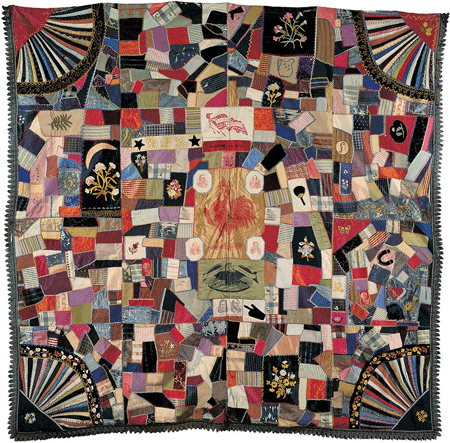On June 4, 1919, U.S. Congress passed the 19th Amendment to the Constitution guaranteeing women the right to vote, and sent it to the states for ratification. To celebrate this momentous anniversary, we are featuring an essay by Stacy C. Hollander, senior curator and director of exhibitions at the American Folk Art Museum, on an anonymous 19th-century artist’s “Crazy” quilt (i.e., a quilt with no repeating motifs) and its message about women’s suffrage.

The constitutional amendment giving the vote to American women was not ratified until 1920. Therefore, the unidentified maker of this quilt voiced her political sentiments in one of the only socially acceptable means available to her in the late nineteenth century. Using the idiom of the Crazy quilt, she constructed a strong statement of Democratic sympathies in a highly fashionable format.
The strutting rooster prominently featured in the center of the quilt was an emblem often used by the Democratic Party during the 1880s and 1890s, particularly in Grover Cleveland’s presidential campaign. Below the rooster are portraits of two unsuccessful Democratic presidential candidates: Samuel J. Tilden of New York, who ran in 1876, and Winfield S. Hancock of Pennsylvania, the candidate in 1880. These fabrics, originally parts of printed campaign banners, evidently were saved by the maker until after Grover Cleveland’s successful bid in the 1884 campaign. Cleveland and his running mate, Thomas A. Hendricks, are shown in the upper corners of the central block. A Cleveland-Hendricks inaugural ribbon, dated March 4, 1885, with an image of an American flag and pileus, is placed above.
In addition to the political references that abound on this textile, the quiltmaker included elements more typically associated with the Crazy quilt aesthetic, including Japanese-inspired corner fans, a small handheld fan, flowers, stars, and a crescent moon. The Japan pavilion at the Philadelphia Centennial Exposition of 1876 is often cited as a significant contributing factor to the development of the American Crazy quilt. The design principles of the Aesthetic Movement, which emphasized surface ornamentation and exoticism, also influenced the direction of American quiltmaking in the last quarter of the nineteenth century. Both come together artfully in this contained Crazy quilt.


